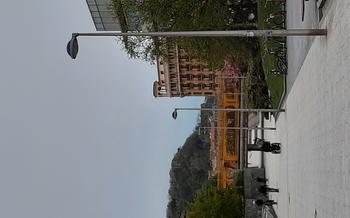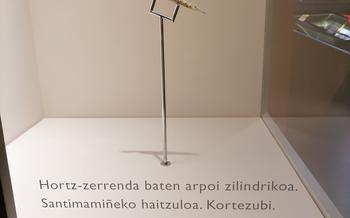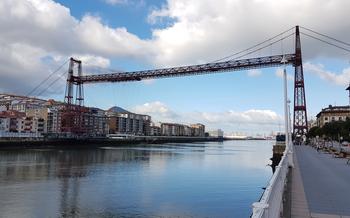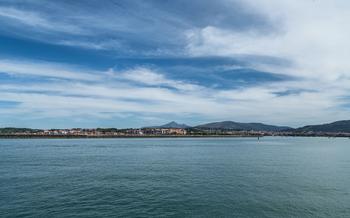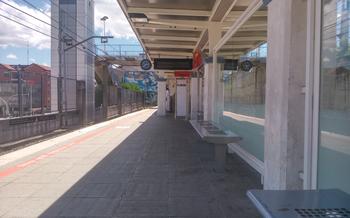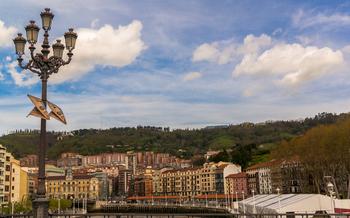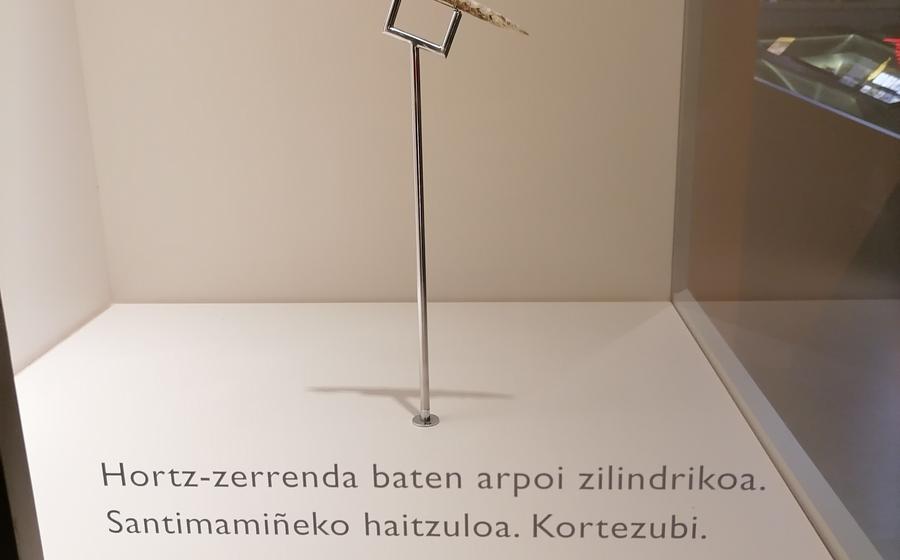
Santimamiñe Cave
- Historical Significance
- Geographical Location:
- Natural Wonders
- Guided Tours
- Archaeological Findings
- Cultural Heritage
- Educational Programs:
- Accessibility:
- Conservation Efforts
- Photography and Videography
- Souvenirs and Merchandise
- Nearby Attractions
- Local Cuisine
- Insider Tip:
Historical Significance
The Santimamiñe Cave holds a profound historical significance that transports visitors back to the dawn of human civilization. Its journey began in the Stone Age, approximately 14,000 years ago, when prehistoric inhabitants left their indelible mark on the cave's walls. These ancient engravings and paintings, discovered in the early 20th century, provide a glimpse into the lives, beliefs, and artistic expressions of our ancestors. The cave's sacred nature is evident through the presence of these artworks, revealing the deep spiritual connection early humans felt with their surroundings. Archaeological excavations and ongoing research at the site continue to unravel the captivating story of the Santimamiñe Cave, shedding light on the mysteries of our prehistoric past.
Geographical Location:
The Santimamiñe Cave is nestled in the heart of the Basque Country, a region in northern Spain renowned for its rich history, culture, and natural beauty. Situated within the municipality of Kortezubi, the cave lies approximately 30 kilometers west of the vibrant city of Bilbao, the Basque Country's largest city and a cultural hub. Surrounded by picturesque mountains, lush forests, and rolling green hills, the cave's location offers visitors a breathtaking blend of history, nature, and adventure.
To reach the Santimamiñe Cave, visitors can take a scenic drive along winding roads that offer panoramic views of the Basque countryside. Alternatively, public transportation options are available, with regular buses connecting Bilbao and Kortezubi. Once in Kortezubi, visitors can follow signs or inquire locally for directions to the cave, which is easily accessible by foot or by car.
Natural Wonders
The Santimamiñe Cave is a captivating natural wonder, renowned for its stunning geological formations. As you venture into its depths, you'll be awestruck by the intricate stalactites and stalagmites that adorn its chambers and passages. These mesmerizing formations, created by the patient work of water over thousands of years, drip and gleam, adding an almost ethereal quality to the cave's atmosphere.
The cave's unique rock formations, sculpted by the relentless forces of nature, tell a story of geological processes that have shaped this underground world. Explore its vast chambers, admire the towering columns, and marvel at the delicate flowstone formations that resemble frozen waterfalls. Each twist and turn reveals new wonders, inviting you to delve deeper into the mysteries of the earth.
The Santimamiñe Cave is not only a geological marvel but also a sanctuary for diverse flora and fauna. As you tread through its corridors, keep an eye out for the resident bats, the silent guardians of this subterranean realm. These fascinating creatures, adapted to the darkness, play a crucial role in the cave's ecosystem. Discover the intricate web of life that thrives within these ancient chambers, a testament to the cave's ecological significance.
Guided Tours
The Santimamiñe Cave offers guided tours led by experienced guides who provide a wealth of knowledge and insights into the cave's history, art, and geology. These tours are essential for visitors who want to make the most of their visit and understand the significance of what they are seeing.
There are several tour options available, ranging from standard tours that cover the main highlights of the cave to extended tours that delve deeper into its history and archaeology. Specialized tours are also available for groups with specific interests, such as art history or geology.
The guides play a crucial role in bringing the cave to life, sharing stories and explanations that help visitors appreciate the cave's significance. They also ensure that visitors follow safety guidelines and respect the cave's environment, preserving it for future generations.
It is important to book your tour in advance, especially during peak season, to avoid disappointment. Tours are conducted in Spanish, Basque, English, and French, and reservations can be made online or by phone.
Archaeological Findings
The Santimamiñe Cave has been the site of extensive archaeological excavations that have uncovered a wealth of artifacts and insights into the lives of prehistoric humans. Among the most significant findings are stone tools, animal bones, and ceramic fragments, which provide evidence of human occupation dating back to the Upper Paleolithic period. These artifacts shed light on the hunting, gathering, and tool-making practices of our ancestors.
The cave also yielded numerous artistic creations, including engravings on bone and stone, as well as portable art objects. These intricate works of art depict animals, human figures, and abstract symbols, offering glimpses into the symbolic and spiritual world of prehistoric humans. The discovery of these artifacts has contributed to our understanding of the cultural and artistic expressions of our ancestors and has provided valuable insights into their beliefs and rituals.
Ongoing research projects and studies continue to unravel the mysteries of the Santimamiñe Cave. Archaeologists and historians are working to piece together the puzzle of human occupation and activity at the site, examining the relationships between the cave's art, artifacts, and environment. Through these ongoing investigations, the cave continues to serve as a valuable source of information, deepening our knowledge of prehistoric life and culture.
Cultural Heritage
The Santimamiñe Cave holds significant cultural heritage within the Basque Country and Spain. It has played a crucial role in shaping local traditions, folklore, and mythology. The cave's prehistoric art and archaeological findings have inspired countless stories, legends, and artistic creations, contributing to the region's rich cultural tapestry.
The Basque people have a deep connection to the cave, as it is considered a symbol of their ancestral heritage. Many local traditions and customs are intertwined with the cave's history and significance. For example, the cave is often mentioned in Basque mythology and folklore, where it is depicted as a place of power and mystery.
In recent years, there have been significant efforts to promote and preserve the cave as a cultural heritage site. The cave has been declared a National Monument and is protected by law. The Basque government has also invested in the cave's conservation and restoration, ensuring its preservation for future generations.
Various festivals, events, and exhibitions are organized throughout the year to celebrate the cave's cultural heritage. These events showcase the cave's prehistoric art, archaeological discoveries, and cultural significance. They provide an opportunity for visitors to learn more about the cave's history and its impact on Basque culture.
Educational Programs:
The Santimamiñe Cave offers a range of educational programs and workshops designed to engage visitors of all ages and backgrounds. These programs aim to raise awareness about the cave's history, art, and conservation efforts, fostering a deeper understanding and appreciation of this unique site.
Families can participate in interactive workshops that introduce children to the cave's prehistoric inhabitants and their way of life. Through hands-on activities and storytelling, kids can learn about the cave's art, explore the process of speleogenesis, and discover the importance of preserving our cultural heritage.
Schools and groups can book guided tours tailored to educational purposes. These tours delve into the cave's archaeological significance, discussing the artifacts discovered and the insights they provide into prehistoric cultures. Students can engage in discussions, ask questions, and gain a deeper understanding of the cave's role in human history.
The cave also collaborates with universities and research institutions to facilitate academic studies and research projects. Researchers have the opportunity to conduct in-depth investigations, utilizing the cave's unique environment and preserved artifacts to further our knowledge of prehistoric art and human evolution.
These educational programs not only enrich the visitor experience but also contribute to the ongoing preservation and study of the Santimamiñe Cave. By promoting a deeper understanding of the cave's significance, these initiatives help ensure that future generations can continue to appreciate and protect this remarkable heritage site.
Accessibility:
The Santimamiñe Cave is committed to ensuring that everyone can experience its wonders, regardless of their abilities or limitations. The cave features several accessibility measures to accommodate visitors with disabilities or special needs.
Wheelchair users and individuals with mobility challenges can take advantage of the cave's accessible entrance and wide pathways. Ramps and handrails are strategically placed throughout the cave to assist visitors in navigating the uneven terrain.
Additionally, the cave offers specialized tours designed for visitors with visual or hearing impairments. Trained guides use tactile models, audio descriptions, and sign language to provide a comprehensive and engaging experience for all.
Visitors with specific accessibility requirements are encouraged to contact the cave's management in advance to discuss their needs and arrange for any necessary accommodations. The cave's staff is dedicated to ensuring that every visitor has a safe and enjoyable experience.
Conservation Efforts
The Santimamiñe Cave's preservation is paramount, given its immense cultural and historical value. To protect this unique site, several conservation efforts have been implemented. Strict visitor regulations limit the number of people allowed inside the cave at a time, ensuring minimal disturbance to its delicate formations and artwork. Specialized lighting systems are used to prevent damage from excessive exposure to artificial light. Regular monitoring and maintenance are conducted to identify and address any potential threats or deterioration. Furthermore, ongoing research and scientific studies contribute to a deeper understanding of the cave's environment, aiding in the development of effective conservation strategies. These efforts collectively aim to preserve the Santimamiñe Cave as a heritage for future generations while allowing responsible and sustainable visitation.
Photography and Videography
When it comes to capturing the essence of Santimamiñe Cave, photography and videography enthusiasts are in for a treat. While preserving the cave's integrity is paramount, visitors are allowed to take photographs and videos for personal use, with a few guidelines to ensure minimal impact. Flash photography is strictly prohibited, as the bright light can damage the delicate cave paintings. Tripods and other photography equipment are permitted, but visitors are requested to be mindful of their surroundings and avoid obstructing other visitors' experiences. Professional photographers and filmmakers seeking special access or permits should contact the cave authorities in advance. By adhering to these regulations, visitors can create lasting memories while respecting the cave's fragile ecosystem.
Souvenirs and Merchandise
At the entrance of the Santimamiñe Cave, a small gift shop awaits visitors who wish to take home a tangible memory of their subterranean adventure. The shop offers a diverse selection of souvenirs and merchandise, skillfully crafted to celebrate the cave's rich history and cultural significance.
From intricately designed postcards that capture the essence of the cave's prehistoric art to meticulously crafted replicas of the cave's iconic stalactites and stalagmites, there's something for every taste and budget. Visitors can also find an assortment of books, ranging from comprehensive guides to the cave's geology and archaeology to captivating children's tales inspired by the cave's mystical aura.
Proceeds from the sale of souvenirs directly contribute to the cave's conservation and educational programs, ensuring that future generations can continue to marvel at this remarkable subterranean treasure. By purchasing a souvenir, visitors not only take home a piece of the Santimamiñe Cave but also become active participants in its preservation.
Nearby Attractions
Beyond the captivating allure of the Santimamiñe Cave, the surrounding region offers a wealth of additional attractions to enrich your Basque Country experience. Venture to the charming medieval town of Kortezubi, nestled amidst rolling green hills, and immerse yourself in its rich history and Basque traditions. Admire the town's ancient stone houses, visit the quaint church, and savor the delectable local cuisine at traditional Basque restaurants.
For nature enthusiasts, the Urdaibai Biosphere Reserve, a UNESCO-designated site, beckons with its pristine beaches, lush forests, and diverse wildlife. Explore the reserve's hiking trails, spot migratory birds in the wetlands, or take a boat trip to observe the playful dolphins and seals.
Just a short drive from the cave, the city of Bilbao awaits with its vibrant cultural scene and architectural marvels. Marvel at the stunning Guggenheim Museum, designed by Frank Gehry, and delve into the city's rich history at the Basque Museum. Stroll along the picturesque Nervión River, indulge in the delectable pintxos (Basque tapas) at local bars, and soak up the lively atmosphere of this vibrant city.
Combine your visit to the Santimamiñe Cave with these nearby attractions to create a memorable Basque Country itinerary that blends history, nature, and culture.
Local Cuisine
Indulge in the culinary delights of the Basque Country, renowned for its rich gastronomy. Savor traditional Basque dishes such as pintxos, small bites often served on bread, featuring a variety of toppings like seafood, cheese, and vegetables. Don't miss the opportunity to try marmitako, a hearty fish stew, or txuleta, a grilled steak. For a taste of the sea, order bacalao al pil pil, a codfish dish cooked in a garlic and olive oil sauce. Complement your meal with a glass of local txakoli wine, a slightly sparkling white wine unique to the region. Explore local food markets, such as the Mercado de la Ribera in Bilbao, to sample fresh produce, seafood, and traditional Basque products. Enhance your culinary experience by taking a cooking class or participating in a food tour to learn more about the Basque culinary traditions.
Insider Tip:
For a truly memorable experience, plan your visit to the Santimamiñe Cave during the summer solstice. On this special day, the sun's rays perfectly align with the cave's entrance, illuminating the innermost chamber with a magical golden glow. This rare celestial event creates a breathtaking spectacle that showcases the cave's natural beauty and ancient significance. Remember to arrive early to secure a spot and witness this extraordinary phenomenon.


